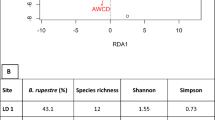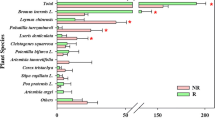Abstract
Ligularia virgaurea, a toxic perennial weed, has become a dominant species in the heavily-grazed alpine meadows of the eastern Qinghai–Tibetan Plateau over recent decades. We investigated changes in soil biochemical properties associated with L. virgaurea spreading in grazed alpine meadows at three sites. Soil and root biomass samples were taken at depths of 0–8 cm, 8–16 cm and 16–24 cm from patches where L. virgaurea was dominant and from areas between L. virgaurea patches, with only other native species. Across sites, root biomass, acid-extracted carbohydrate C, organic C and N mineralization, and microbial biomass C and N concentrations in the top 8-cm layer were significantly higher while nitrate N concentration was significantly lower in L. virgaurea patches than in areas between L. virgaurea patches. The increased activities of dehydrogenase, β–glucosidase, urease and phosphatase in the top 8-cm layer under L. virgaurea were associated with enhanced soil microbial biomass. Our results indicate a close association between changes in soil biochemical properties in the top 8-cm layer and the spread of L. virgaurea in grazed alpine meadows of the eastern Qinghai–Tibetan Plateau.




Similar content being viewed by others
References
Acosta-Martínez V, Cruz L, Sotomayor-Ramírez D, Pérez-Alegría L (2007) Enzyme activities as affected by soil properties and land use in a tropical watershed. Appl Soil Ecol 35:35–45
Baker HG (1986) Patterns of plant invasion in North America. In: Mooney HA, Drake JA (eds) Ecology of Biological Invasions of North America and Hawaii. Springer, New York, pp 44–57
Beck T, Joergensen RG, Kandeler E, Makeschin F, Nuss E, Oberholzer HR, Scheu S (1997) An inter-laboratory comparison of ten different ways of measuring soil microbial biomass C. Soil Biol Biochem 29:1023–1032
Bezemer TM, Lawson CS, Hedlund K, Edwards AR, Brook AJ, Igual JM, Mortimer SR, Van Der Putten WH (2006) Plant species and functional group effects on abiotic and microbial soil properties and plant-soil feedback responses in two grasslands. J Ecol 94:893–904
Blagodatskaya EV, Blagodatsky SA, Anderson TH, Kuzyakov Y (2009) Contrasting effects of glucose, living roots and maize straw on microbial growth kinetics and substrate availability in soil. Eur J Soil Sci 60:186–197
Bradford MA, Fierer N, Reynolds JF (2008) Soil carbon stocks in experimental mesocosms are dependent on the rate of labile carbon, nitrogen and phosphorus inputs to soils. Funct Ecol 22:964–974
Brink RH, Dybar P, Lynch DL (1960) Measurement of carbohydrates in soil hydrolysates with anthrone. Soil Sci 89:157–166
Brookes PC, Landman A, Pruden G, Jenkinson DS (1985) Chloroform fumigation and the release of soil nitrogen: A rapid direct extraction method to measure microbial biomass nitrogen in soil. Soil Biol Biochem 17:837–842
Caravaca F, Alguacil MM, Torres P, Roldán A (2005) Plant type mediates rhizospheric microbial activities and soil aggregation in a semiarid Mediterranean salt marsh. Geoderma 124:375–382
Chantigny MH, Angers DA, Beauchampet CJ (2000) Decomposition of de-inking paper sludge in agricultural soils as characterized by carbohydrate analysis. Soil Biol Biochem 32:1561–1570
Dornbush ME (2007) Grasses, litter, and interaction affect microbial biomass and soil enzyme activity. Soil Biol Biochem 39:2241–2249
Ehrenfeld JG (2003) Effects of exotic plant invasions on soil nutrient cycling processes. Ecosystems 6:503–523
Fargione J, Tilman D (2006) Plant species traits and capacity for resource reduction predict yield and abundance under competition in nitrogen-limited grassland. Funct Ecol 20:533–540
Fioretto A, Papa S, Pellegrino A, Ferrigno A (2009) Microbial activities in soils of a Mediterranean ecosystem in different successional stages. Soil Biol Biochem 41:2016–2068
Goslee SC, Peters DPC, Beck KG (2001) Modeling invasive weeds in grasslands: the role of allelopathy in Acroptilon repens invasion. Ecol Model 139:31–45
Gregorich EG, Carter MR, Angers DA, Monreal CM, Ellert BH (1994) Towards a minimum data set to assess soil organic matter quality in agricultural soils. Can J Soil Sci 74:367–385
Groffman PM, Eagan P, Sullivan WM, Lemunyon JL (1996) Grass species and soil type effects on microbial biomass and activity. Plant Soil 183:61–67
Haynes RJ, Swift RS, Stephen RC (1991) Influence of mixed cropping rotations (pasture–arable) on organic matter content, water stable aggregation and clod porosity in a group of soils. Soil Till Res 19:77–87
Insam H, Haselwandter K (1989) Metabolic quotient of the soil microflora in relation to plant succession. Oecologia 79:174–178
Institute of Soil Science (1978) Physical and Chemical Analysis Methods of Soil. Shanghai Science Technology Press, Shanghai
Institute of Soil Science (1986) The soil atlas of China. Cartographic Publishing House, Beijing
Janssens F, Peeters A, Tallowin JRB, Bakker JP, Bekker RM, Fillat F, Oomes MJM (1998) Relationship between soil chemical factors and grassland diversity. Plant Soil 202:69–78
Jones DL, Nguyen C, Finlay RD (2009) Carbon flow in the rhizosphere: carbon trading at the soil-root interface. Plant Soil 321:5–33
Kleijn D, Müller-Schärer H (2006) The relation between unpalatable species, nutrients and plant species richness in Swiss montane pastures. Biodivers Conserv 15:3971–3982
Klose S, Tabatabai MA (2000) Urease activity of microbial biomass in soils as affected by cropping systems. Biol Fertil Soils 31:191–199
Kulmatiski A, Beard KH, Stevens JR, Cobbold SM (2008) Plant-soil feedbacks: a meta-analytical review. Ecol Lett 11:980–992
Kuzyakov Y (2010) Priming effects: interactions between living and dead organic matter. Soil Biol Biochem 42:1363–1371
Kuzyakov Y, Domanski G (2000) Carbon input by plants into the soil. Review. J Plant Nutr Soil Sc 163:421–431
Li XG, Rengel Z, Mapfumo E, Singh B (2007) Increase in pH stimulates mineralization of “native” organic carbon and nitrogen in naturally salt-affected sandy soils. Plant Soil 290:269–282
Li XW, Sun K, Ma RJ, Cao Y (2003) Gannan natural grassland poisonous plants and prevention and cure countermeasures. Pratacultural Sci 20:60–63
Lynch JM, Whipps JM (1990) Substrate flow in the rhizosphere. Plant Soil 129:1–10
Liu SW (1989) Compositae (4). In: Editorial Board of Flora of China, Chinese Academy of Sciences (eds) Flora of China, vol 77(2). Science Press, Beijing, pp 112–115
Ma RJ, Du GZ, Liu ZJ, Chen JK (2002) Regenerative strategies of three species of Ligularia (Asteraceae) in eastern Qinghai-Xizang plateau of China. I. From flowering to germination. Pratacultural Sci 11:29–36
Ma RJ, Wang ML, Zhu XT, Lu XW, Sun K (2005) Allelopathy and chemical constituents of Ligularia virgaurea volatile. Chin J Appl Ecol 16:1826–1829
Moretto AS, Diste RA, Didoné NG (2001) Decomposition and nutrient dynamic of leaf litter and roots from palatable and unpalatable grasses in a semi-arid grassland. Appl Soil Ecol 18:31–37
Nannipieri P, Eldor P (2009) The chemical and functional characterization of soil N and its biotic components. Soil Biol Biochem 41:2357–2369
Nelson DW, Sommers LE (1982) Total carbon, organic carbon and organic matter. In: Page AL, Miller RH, Keeney DR (eds) Methods of Soil Analysis, Part 2, Chemical and Microbiological Properties Agronomy Monograph, vol 9, 2nd edn. American Society of Agronomy Inc., Madison, pp 539–579
Nguyen C (2003) Rhizodeposition of organic C by plant: mechanisms and control. Agronomie 23:375–396
Parkinson JA, Allen SE (1975) A wet oxidation procedure suitable for the determination of nitrogen and mineral nutrients in biological material. Commun Soil Sci Plan 6:1–11
Puget P, Angers DA, Chenu C (1999) Nature of carbohydrates associated with water-stable aggregates of two cultivated soils. Soil Biol Biochem 31:55–63
Ren Z, Li Q, Chu C, Zhao L, Zhang J, Ai D, Yang Y, Wang G (2010) Effects of resource additions on species richness and ANPP in an alpine meadow community. J Plant Ecol UK 3:25–31
Shan BQ, Du GZ, Liu ZH (2000) Clonal growth of Ligularia virgaurea: Morphological responses to nutritional variation. Acta Phytoecol Sin 24:46–51
Shi W, Yao H, Bowman D (2006) Soil microbial biomass, activity and nitrogen transformations in a turfgrass chronosequence. Soil Biol Biochem 38:311–319
Soil Survey Staff (1975) Soil Taxonomy. A Basic System of Soil Classification for Making and Interpreting Soil Survey. US Government Printing Office, Washington, D.C
Sun G, Luo P, Wu N, Qiu PF, Gao YH, Chen H, Shi FS (2009) Stellera chamaejasme L. increases soil N availability, turnover rates and microbial biomass in an alpine meadow ecosystem on the eastern Tibetan Plateau of China. Soil Biol Biochem 41:86–91
Tabatabai MA (1982) Soil enzymes. In: Miller RH (ed) Methods of soil analysis, part 2. Chemical and microbiological properties, 2nd edn. American Society of Agronomy, Madison, pp 903–943
Timsina B, Shrestha BB, Rokaya MB, Münzbergová Z (2011) Impact of Parthenium hysterophorus L. invasion on plant species composition and soil properties of grassland communities in Nepal. Flora 206:233–240
Udawatta RP, Kremer RJ, Adamson BW, Anderson SH (2008) Variations in soil aggregate stability and enzyme activities in a temperate agroforestry practice. Appl Soil Ecol 39:153–160
van Hees PAW, Jones DL, Finlay R, Godbold DL, Lundströmd US (2005) The carbon we do not see—the impact of low molecular weight compounds on carbon dynamics and respiration in forest soils: a review. Soil Biol Biochem 37:1–13
Vance ED, Brookesa PC, Jenkinson DS (1987) An extraction method for measuring soil microbial biomass C. Soil Biol Biochem 19:703–707
Vitousek PM, Howarth RW (1991) Nitrogen limitation on land and in the sea – how can it occur? Biogeochemistry 13:87–115
Wardle DA, Nicholson KS (1996) Synergistic effects of grassland plant species on soil microbial biomass and activity: implications for ecosystem-level effects of enriched plant diversity. Funct Ecol 10:410–416
Wedin D, Tilman D (1993) Competition among grasses along a nitrogen gradient: initial conditions and mechanisms of competition. Ecol Monogr 63:199–229
Windham L, Ehrenfeld JG (2003) Net impact of a plant invasion on nitrogen-cycling processes within a brackish tidal mash. Ecol Appl 13:883–897
Wu GL, Li W, Li XP, Shi ZH (2011) Grazing as a mediator for maintenance of offspring diversity: sexual and clonal recruitment in alpine grassland communities. Flora 206:241–245
Wu WX, Ye QF, Min H, Duan XJ, Jin WM (2004) Bt-transgenic rice straw affects the culturable microbiota and dehydrogenase and phosphatase activities in a flooded paddy soil. Soil Biol Biochem 36:289–295
Acknowledgements
This study was financed by Research Fund for the Doctoral Program of Higher Education (200807300016), innovation group project of China Ministry of Education, and National Natural Science Foundation of China (40930533). We thank three anonymous reviewers for their comments on this manuscript.
Author information
Authors and Affiliations
Corresponding author
Additional information
Responsible Editor: Jeff R. Powell.
Electronic supplementary material
Below is the link to the electronic supplementary material.
ESM 1
(DOC 41 kb)
Rights and permissions
About this article
Cite this article
Shi, X.M., Li, X.G., Wu, R.M. et al. Changes in soil biochemical properties associated with Ligularia virgaurea spreading in grazed alpine meadows. Plant Soil 347, 65–78 (2011). https://doi.org/10.1007/s11104-011-0818-7
Received:
Accepted:
Published:
Issue Date:
DOI: https://doi.org/10.1007/s11104-011-0818-7




